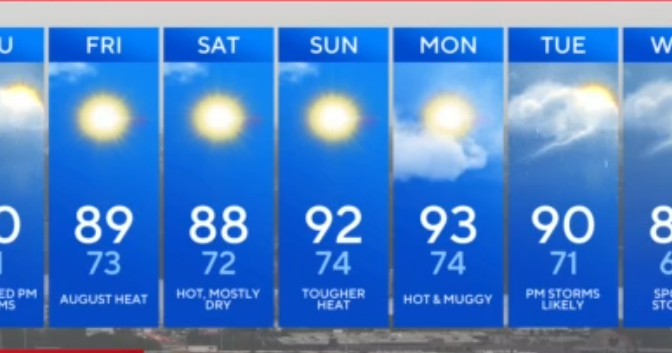Is the Amber Heat Health Alert Justified with 33°C on the Horizon?

Understanding the Impact of the Current Heatwave in the UK
As the UK experiences its fourth heatwave of the summer, an amber heat health alert is in effect until 1800 on Wednesday. This alert signifies that temperatures will soar into the high 20Cs and low 30Cs, particularly affecting regions like the East Midlands, Lincolnshire, and Yorkshire. Forecasts predict a maximum temperature of 33C on Wednesday afternoon, raising concerns about the health implications for vulnerable populations.
The Met Office describes Wednesday's weather as presenting "a more complex picture," where high temperatures coincide with an increased likelihood of thunderstorms across northern areas. A yellow weather warning for thunderstorms has been issued for parts of Scotland, covering northern, central, and south-east regions. This warning is in effect from 14:00 until midnight, indicating that heavy showers and thundery conditions could lead to localized disruptions, including road spray and flash flooding.
Implications of the Heatwave Across the UK
While Scotland and Northern Ireland may not officially be classified as experiencing a heatwave due to the three consecutive day rule, they are still seeing temperatures well above average for this time of year. Forecasts predict temperatures ranging from 25C to 29C on Wednesday. In contrast, southern regions of England have already met the criteria for a heatwave, with three consecutive days exceeding the requisite temperature thresholds.
An amber heat health alert—issued by the UK Health Security Agency (UKHSA) and the Met Office—indicates significant health impacts due to extreme weather conditions. This is particularly concerning for individuals aged over 65 and those with pre-existing health conditions who are at heightened risk during such events. The amber alerts encompass London, the South East, East of England, West Midlands, and East Midlands, while a yellow alert is in place for the South West, North East, North West, and Yorkshire and the Humber.
Climate Change and the Increasing Frequency of Heatwaves
The current heatwave is not an isolated incident; it is part of a troubling trend exacerbated by climate change. A recent report from the World Health Organization (WHO) indicates that extreme weather events in Europe should be treated as a health emergency. According to the Pan-European Commission on Climate and Health, heat-related mortality in Europe has surged by 30% over the past two decades, resulting in over 100,000 deaths. This alarming statistic underscores the urgent need for addressing the public health implications of climate change.
Workplace Temperature Regulations and Health Risks
Despite the evident risks associated with extreme heat, the UK currently lacks specific laws regulating maximum workplace temperatures. Employers are obligated to maintain a comfortable working environment, yet calls for establishing a maximum working temperature of 30C have emerged. Trade union Unite advocates for the cessation of work when temperatures exceed this threshold and when adequate protective measures, such as shaded areas, are not available outdoors.
The risks associated with overheating are significant. Heat exhaustion and heatstroke, the latter being a medical emergency requiring immediate treatment, can affect anyone but particularly threaten older adults, young children, and individuals with chronic health conditions. Awareness and preparedness are crucial in mitigating these risks.
What to Expect Over the Coming Days
As we look ahead to the remainder of the week, it appears that the heat will ease for most by Thursday, accompanied by thunderstorms and cooler, less humid air expected to arrive by Friday. Nevertheless, eastern and south-eastern England will still experience very warm temperatures reaching up to 29C. Other regions can expect slightly lower temperatures, ranging from 24C to 27C.
Friday could see a resurgence of heat, with temperatures in south-eastern England likely to exceed 30C, while the rest of England and Wales will remain in the mid to high 20s. The warm weather is expected to persist into the weekend, characterized by intermittent cloudiness but plenty of sunshine for most areas.
Drought Conditions and Their Consequences
The lack of significant rainfall poses another pressing concern, particularly for farmers and growers who are already grappling with the impacts of drought and hosepipe bans. The national drought group, which includes the Met Office, water regulators, and government officials, has reported widespread environmental effects due to the ongoing water shortage. This situation has severely impacted farming, wildlife, and has increased the risk of wildfires.
Regions such as Yorkshire, Cumbria, Lancashire, Greater Manchester, Merseyside, Cheshire, East Midlands, and West Midlands are currently experiencing drought conditions. Furthermore, areas in north-east England, Lincolnshire, and Northamptonshire, as well as parts of East Anglia, Thames, Wessex, Solent, and South Downs, are classified as being in prolonged dry weather—an indicator that could lead to drought if conditions do not improve.
The Historical Context of the Drought
This summer has already seen drought conditions arise earlier than expected, following an extended period of low rainfall and what has been recorded as the sixth driest spring since 1836. As a consequence, millions of people across England are now bound by hosepipe bans aimed at curtailing water consumption. These restrictions are critical not just for conserving water resources but also for protecting the environment and managing the public health risks associated with heatwaves.
Conclusion
The current heatwave and associated weather patterns serve as a stark reminder of the ongoing challenges posed by climate change. As temperatures rise and the likelihood of severe weather events increases, it is imperative for individuals, communities, and governments to take proactive measures to mitigate the effects on health, agriculture, and the environment. The importance of awareness and preparedness cannot be overstated, particularly for those most vulnerable during extreme weather conditions.
As we navigate these increasingly frequent heatwaves, what steps will you take to stay informed and prepared? How can we collectively address the challenges posed by climate change and extreme weather? #Heatwave #ClimateChange #HealthEmergency
FAQs
What is the amber heat health alert in the UK?
An amber heat health alert signifies that high temperatures are likely to impact health, particularly for vulnerable populations such as the elderly and those with pre-existing health conditions.
What temperature qualifies as a heatwave in the UK?
A heatwave in the UK is defined as three consecutive days with temperatures exceeding a certain threshold: 25C for most areas and 28C for London and its surroundings.
What are the health risks associated with extreme heat?
Health risks from extreme heat include heat exhaustion and heatstroke, which can be life-threatening, particularly for vulnerable groups such as older adults and young children.
How can I stay safe during a heatwave?
To stay safe during a heatwave, drink plenty of water, avoid strenuous activities during peak heat, stay indoors in a cool environment, and be mindful of the signs of heat-related illnesses.
Published: 2025-08-13 12:00:32 | Category: technology



